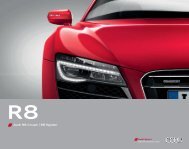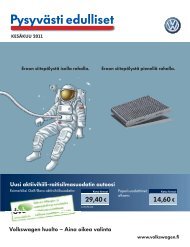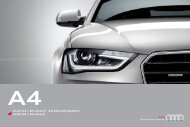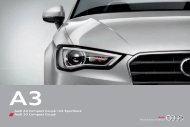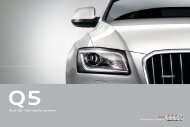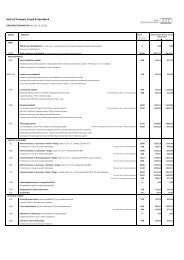Audi A7 Sportback Audi S7 Sportback
Audi A7 Sportback Audi S7 Sportback
Audi A7 Sportback Audi S7 Sportback
You also want an ePaper? Increase the reach of your titles
YUMPU automatically turns print PDFs into web optimized ePapers that Google loves.
44<br />
quattro®/quattro® with sport differential<br />
Why only use two wheels<br />
when a car has four?<br />
The quattro® permanent all-wheel drive.<br />
quattro is a permanent all-wheel drive system.<br />
If the wheels on one axle of the vehicle lose<br />
grip on the road and threaten to spin, then the<br />
drive force is transferred to the other axle –<br />
automatically and permanently distributed<br />
through the centre differential. The basic<br />
distribution is 40 : 60 – 40 % of the power comes<br />
from the front axle, 60 % from the rear. The<br />
benefit is better traction during acceleration and<br />
improved safety due to exceptional grip. So much<br />
for the technology. But what makes quattro<br />
unique is really the driving feel. “As if you are<br />
stuck to the road,” some customers say. We put it<br />
like this: quattro gives you a better feel for the<br />
road and thus more safety.<br />
The optional quattro with sport differential<br />
further reinforces this unmistakeable quattro<br />
feeling. Vehicles tend to experience understeer<br />
when steering or driving into corners. This is a<br />
normal physical process: a moving object<br />
opposes a change in direction. The elastic tyres<br />
and the suspension mounts tense up until the new<br />
direction has been adopted. When accelerating<br />
into a corner, the load on the front axle is reduced<br />
and it therefore transfers less lateral force to the<br />
tyres – the vehicle understeers. With the sport<br />
differential on the rear axle, the tendency has<br />
been significantly counteracted. This is because<br />
the quattro rear axle differential has been<br />
extended left and right by a clutch system with<br />
two gear levels. They ensure that the individual<br />
wheels on the rear axle receive different levels of<br />
torque. The clutches are activated by an electrohydraulic<br />
actuator. Depending, for example, on<br />
the steering angle, lateral acceleration, yaw<br />
angle and driving speed, the system calculates<br />
the right distribution of wheel torque for any<br />
driving situation. In this way the power is<br />
specifically channelled to the outer rear wheel<br />
when steering or accelerating into a corner. The<br />
effect: the vehicle is effectively pressed into the<br />
corner by the drive force and follows the angle of<br />
the front wheels. The variable left and right drive<br />
forces also help stabilise the steering and the<br />
usual steering corrections are hardly necessary.





